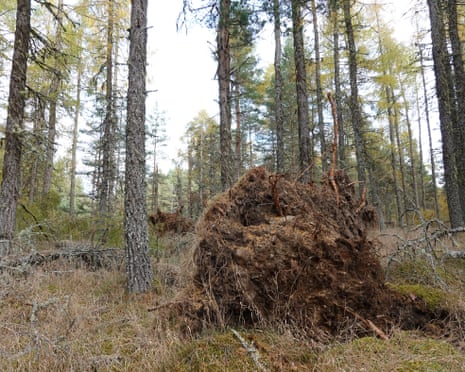Top Stories
Storm Amy Reshapes Pinewood Ecosystem in Scotland’s Highlands

The recent arrival of Storm Amy has significantly impacted the pinewood ecosystem in Scotland. As the storm swept through the region, it caused numerous trees to fall, altering the landscape and the habitats within it. The aftermath reveals a complex interplay between nature’s fury and the resilience of the forest.
Transformations in the Pinewood
The once vibrant greens of summer have begun to shift, with broadleaf trees such as larches and birches changing to hues of green-yellow and bronze. Walking along a path lined with larches and Scots pines, the effects of Storm Amy are evident. Trees have been windthrown, creating new gaps that expose previously unnoticed “granny” pines, which serve as reminders of the forest’s history.
As I navigate through this area, the sound of crackling twigs and branches underfoot accompanies my journey. The landscape, primarily a plantation, showcases a uniformity in tree age and size, alongside a few veteran trees that hint at a time long past. The storm’s path is marked by fallen trees that have created diagonal lines across the ground, resembling nature’s own domino effect.
Ecological Changes and New Opportunities
The fallen trees are not just casualties; they signify a shift in the ecosystem. As these trees decompose, they will provide habitats for various species, including beetles, ants, and fungi, some of which are rare and thrive on deadwood. This process will introduce new life stages to the forest, allowing for more light to penetrate and foster the growth of pioneer species like birch, rowan, and possibly juniper.
The root plates of these fallen trees rise to my height, creating spots that could serve as dust baths for capercaillies, should they be in the area. These holes may also accumulate water, attracting aquatic plants, amphibians, and insects, including dragonflies and their larvae. With more space available, the remaining trees will have the opportunity to flourish.
As the wind picks up, it drowns out the sounds of the coal tit and crestie, leaving behind an eerie silence. The upper branches begin to sway, and a shower of birch leaves descends, illuminated by the fading afternoon sun. In this moment, the vulnerability of the forest becomes palpable, prompting me to consider the balance of beauty and chaos in nature.
The ongoing transformations in this Scottish pinewood highlight the resilience of the ecosystem in the face of powerful storms. As these changes unfold, the forest will continue to adapt, revealing the intricate connections that define its existence.
For those interested in exploring the intersection of nature and literature, “Under the Changing Skies: The Best of the Guardian’s Country Diary, 2018-2024” is available for purchase through Guardian Faber, offering insights into the natural world and its continual evolution.
-

 Health2 months ago
Health2 months agoNeurologist Warns Excessive Use of Supplements Can Harm Brain
-

 Health3 months ago
Health3 months agoFiona Phillips’ Husband Shares Heartfelt Update on Her Alzheimer’s Journey
-

 Science4 weeks ago
Science4 weeks agoBrian Cox Addresses Claims of Alien Probe in 3I/ATLAS Discovery
-

 Science4 weeks ago
Science4 weeks agoNASA Investigates Unusual Comet 3I/ATLAS; New Findings Emerge
-

 Science3 weeks ago
Science3 weeks agoScientists Examine 3I/ATLAS: Alien Artifact or Cosmic Oddity?
-

 Science3 weeks ago
Science3 weeks agoNASA Investigates Speedy Object 3I/ATLAS, Sparking Speculation
-

 Entertainment4 months ago
Entertainment4 months agoKerry Katona Discusses Future Baby Plans and Brian McFadden’s Wedding
-

 World2 months ago
World2 months agoCole Palmer’s Cryptic Message to Kobbie Mainoo Following Loan Talks
-

 Entertainment4 months ago
Entertainment4 months agoEmmerdale Faces Tension as Dylan and April’s Lives Hang in the Balance
-

 Science3 weeks ago
Science3 weeks agoNASA Scientists Explore Origins of 3I/ATLAS, a Fast-Moving Visitor
-

 Entertainment4 months ago
Entertainment4 months agoLove Island Star Toni Laite’s Mother Expresses Disappointment Over Coupling Decision
-

 Entertainment3 months ago
Entertainment3 months agoMajor Cast Changes at Coronation Street: Exits and Returns in 2025









